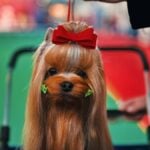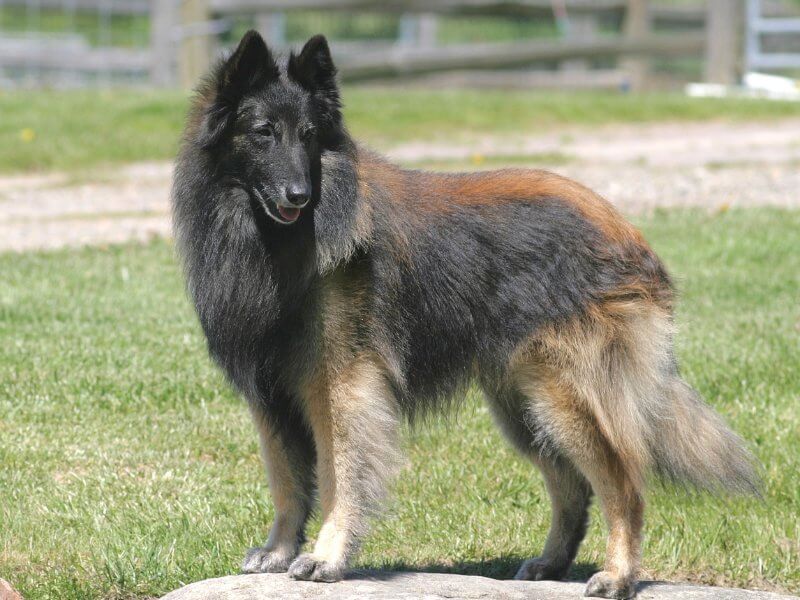
Home » A Simple Formula for Judging the Belgian Tervuren

How to judge Belgian Tervuren – here is a simple formula from one breeder-judge. First select for type and temperament, and then find the best-moving dogs among that subset of typical, mentally sound dogs. Easy… right?
What makes type in a Tervuren? Think about the overall criteria falling into five “buckets” of characteristics:
Think square silhouette and remember from high school trigonometry that “off-square” really IS a rectangle. Our Tervuren are measured from point of shoulder (NOT point of breastbone) to point of rump. They have full britches, and the males carry a collarette—both of which can add the illusion of length. Stand back. Look at where the dog’s feet stand naturally… if you need to squint your eyes to get the overall proportions of height to length, go ahead! A Tervuren does not “stand” over a very large piece of real estate. You will see dogs that appear square enough from afar, but they stand over a lot of ground and have straighter fronts and rears. This is not correct.
Next, look for an elegant length of neck. The withers are accentuated and the topline is level. There is a very moderate tuck-up (seen best in those out-of-coat adolescent girls and boys) and a medium-long croup. Check out the tail. Does it reach the hock? When the dog moves, is the tail an extension of the backline, raised only slightly? Adolescent males and our stud dogs will often raise their tails in the show ring. Take that into consideration, but this breed should never exhibit a high tail carriage or gay tail. And, of course, in Tervuren, “a cropped or stump tail” is a disqualification.
Look at the proportions of depth of body (withers to elbow) to length of leg… they should be equal. A heavily coated dog can appear a tad short on leg… or he may truly be short on leg. An out of coat dog may look a bit high-stationed. Again, stand back and look at those proportions. Try to divine where the dog’s elbow is from afar. Then, on your exam, verify the placement. Balance is extremely important in a breed that must be able to turn on a dime and head off “full-tilt boogie” in another direction. Check out the dog’s loin on exam… it should be relatively short. Shoulders should be well laid-back while rear angulation is in balance with the front. We do not want dogs with “a ton” of rear, coupled with a straight front that cannot handle all the drive from behind. Balance, balance, balance…
Remember, the Tervuren has both an upper and lower height DQ and these differ from the other Belgian breeds. If you have any question about the height of a particular dog, always use the wicket.
Balanced head proportions and dentition:“Well-chiseled… long without exaggeration.” This is a head with flat cheeks, parallel planes, moderate stop, and flat backskull equal in length to the muzzle. When we ask you to look for a typical well-chiseled head, we are not seeking a Collie head. Our dogs have a “MODERATE” stop and a “moderately pointed” muzzle. There is that word again… moderate. The zygomatic arch on a Belgian is flat, so bulging cheeks and thick-set heads are not true to type. More about color later, but the acceptable ranges of masking can fool you into thinking a head is too lean or too chunky… use your hands gently to verify what your eyes are telling you.
Our Breed Standard asks for a “scissors or a level bite” with full dentition. We consider dogs missing “four or more” teeth as having a serious fault, and disqualify dogs with “an undershot bite such that there is a complete loss of contact by all the incisors.” “Overshot and undershot teeth are a fault.” When examining the bite, please gently lift the front lip to check for occlusion, and then gently lift the lips on each side to check for full dentition. Our Judges Education Committee asks specifically that you DO NOT PRY OPEN THE MOUTH to check for missing teeth. Typically, if our Tervuren are missing teeth, they will be at the PM1 and PM2 locations. This is an owner-handled breed and the dogs are not trained for a “wide-open alligator” mouth exam. Enough said.
Expression, eyes and ears: The Standard asks for a slightly almond eye, dark brown in color, medium-sized. Beautiful dark eyes paired with small, triangular ears set high on the head give a Tervuren that “typical” alert, intelligent, questioning, and ready for action expression. Low-set ears, ears that touch, large flat ears, and round, light eyes spoil that ideal expression. And “hanging ears, as on a hound are a disqualification.”
Coat and color: Our dogs carry a double coat of moderate length, well-fitting to the body. Texture (medium harsh) is more important than length. Originally developed as an all-purpose herding/farm dog, Tervs needed a “no fuss” coat that would keep them dry in the rainy “typical” climate of Belgium; cool in the summer and warm in the winter. Fast forward to 2023 and the fashion is to blow-dry show dogs until they resemble large dandelions ready to go poof! This is not correct—it spoils the texture and masks the outline of the dog. This is a natural dog and we ask for minimal trimming of feet and hocks. Period. Sculpted outlines should not be rewarded.
Kindly remember that seasonal shedding is normal for both dogs and bitches. Note that the bitches never, ever carry as long or luxurious a coat as the males. Please do not penalize a more lightly coated bitch. You will show your ignorance of our breed if you do.
So, what about color? Invariably, every judge learner asks about color. The Standard says: “Body rich fawn to russet mahogany with black overlay is ideal and preferred. Predominate color that is pale, washed out, cream or gray is a fault.” Let’s look back in the history of this breed as we learn about color. The Belgian Tervuren was nearly decimated in the Second World War, and the post-war European “Father of the Tervuren variety,” a dog named Willy de la Garde Noire, was described as a “pale fawn dog.” So, it is really not surprising that the “cooler” colored (cream, grey, silver, grey-beige) Tervuren continue to appear out of “warmer” colored (rich fawn to deep mahogany) parents.
For those of you who began judging Tervuren prior to 2007, the AKC Standard’s wording on color changed due to a 2/3-majority vote of the American Belgian Tervuren Club. Now, as a judge, you must balance a simple color fault against the ability of each dog to do its work. As a breeder-judge, it is my personal opinion that we must “build strong houses first… and then paint them.” There are those within the breed who would disagree with me. You must make your own decision. Know that there have been National Specialty winners across all ranges of color.
I would suggest that color be considered as a finishing aspect except for those colors that must be penalized more stringently: “absence of blackening in mature males is a serious fault.” “A face with a complete absence of black is a serious fault.” “White is permitted on the chest/sternum only, not to extend more than 3 inches above the prosternum, and not to reach either point of shoulder.” Long chest hairs may give the illusion of too much white. If you have a question, look closely at the skin at the base of the haircoat. And always remember that white is permitted on the tips of the toes and is typical as “frost” on the muzzle and chin.
Truly fundamental color issues are called out as Disqualifications for the breed: “Solid black, solid liver or any area of white EXCEPT as specified on the chest, tips of the toes, chin, and muzzle.”
Our Standard is clear that we expect our dogs to “be approachable, standing his ground and showing confidence to meet overtures without himself making them” and goes on to say, “In his relationship with humans he is observant and vigilant with strangers, but not apprehensive. He does not show fear or shyness.”
Herding breeds by their very nature are reactive. They take in the big picture of a flock and its movement and “react” appropriately. As an all-purpose farm dog, they were expected to “react” appropriately to strangers appearing on the property… deciding who should be greeted or who should be deterred. It’s a tightrope walk for a young, “vigilant with strangers” Belgian. So what should you expect in the ring?
First, remember this is an owner-handled breed. Tervuren are never presented stacked nose to tail like many Sporting breeds. Do not expect your Terv entry to stand like statues. These are bright, active, busy dogs that free-stack and bait.
Your approach is really important. Be confident. Expect good behavior. Speak to the handler upon approach, put your hand under the dog’s chin, and pet them gently on the head as you greet the dog. Then, just get on with your examination. Personally, in youngsters, I like to examine the dog first, always keeping my hands in contact with the dog’s body or neck. Then I come back to examine the bite, as that is the most invasive part of the exam.
If you feel you cannot safely examine the dog, please do not push. Excuse the dog and explain to the handler why. Judging is not a test of courage or machismo. Please, do not reward dogs that will not stand for examination without being propped up or held in a death grip by their owner. Do allow puppies some reassurance and a bit of stabilizing by their owner-handlers. We want our Tervuren Champions deserving in every aspect—Type, Temperament, and Movement. There are many, many, many Tervuren with excellent character to select from.
So, you have selected the best dogs by evaluating type and temperament. Next, you must find the very best in movement. Since most judges come into the ring already evaluating movement fairly well, I am addressing it last. This is NOT a message that movement is unimportant. Au Contraire! Our Tervs are single-trackers with an easy, effortless, ground-covering gait. They should be moved on a loose lead and never raced around the ring! A Belgian must be balanced in its movement… “Lively and graceful, covering the maximum ground with minimum effort.” You know all those faults of crabbing, padding, hackneying, weaving, etc.? Well, they are just as faulty in our Tervs and “are to be penalized according to the degree with which they interfere with the ability of the dog to work.”
When making your decisions as to whether a fault is minor, serious, or major, our Standard asks you to use the following guide:
The Judge’s Education Committee of the American Belgian Tervuren Club is ready to assist you in your learning. Contact information and excellent study materials are available at: www.abtc.org
Showsight Magazine is the only publication to offer dedicated Digital Breed Magazines for all recognized AKC Breeds.
Read and learn more about the Belgian Tervuren dog breed with articles and information in our Belgian Tervuren Breed Magazine.
Error embedding FlippingBook shortcode, please check the flipbook url. (https://digital.showsightmagazine.com/view/165590/)
